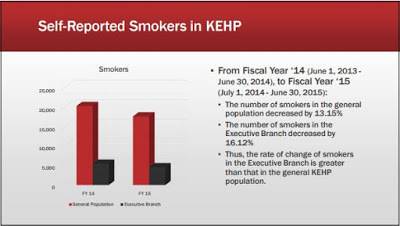State-property smoking ban seems to cut share of smokers in Executive Branch, more than other employees in state health plan

Kentucky Health News
State-government moves against smoking have reduced it among Executive Branch employees at a greater rate than among state employees who were not affected by Gov. Steve Beshear’s order that banned smoking on state property, according to the Department of Employee Insurance.
Beshear’s executive order on Nov. 20, 2014 banned all tobacco products and e-cigarettes in state-owned or state-leased buildings, in state-owned vehicles and on state property. This order was aimed at helping achieve his kyhealthnow goal of reducing smoking rates by 10 percent by 2019.
 Employment Insurance Commissioner Joe Cowles compared a control group – all the self-reported smokers in the Kentucky Employees Health Plan, which includes the executive branch, school boards, retirees and quasi-groups, a total of 265,000 people – to the Executive Branch, which makes up about 20 percent of the total and was the only one affected by the order.
Employment Insurance Commissioner Joe Cowles compared a control group – all the self-reported smokers in the Kentucky Employees Health Plan, which includes the executive branch, school boards, retirees and quasi-groups, a total of 265,000 people – to the Executive Branch, which makes up about 20 percent of the total and was the only one affected by the order.
The study found that from fiscal year 2014 to fiscal year 2015, the number of smokers in the health plan’s population decreased 13 percent while the number of smokers in the Executive Branch population fell 16 percent.
 “So what we found here is two-fold,” Cowles said at at the Aug. 5 kyhealthnow oversight meeting in Frankfort. “The self-reported smokers actually decreased from ’14 to ’15, which is good . . . but it decreased more in the Executive Branch. We are not ready to take the trophy and have a parade on Main Street, but I think as we talk about the trends, early trends, with it eight to 10 months in, we are there.”
“So what we found here is two-fold,” Cowles said at at the Aug. 5 kyhealthnow oversight meeting in Frankfort. “The self-reported smokers actually decreased from ’14 to ’15, which is good . . . but it decreased more in the Executive Branch. We are not ready to take the trophy and have a parade on Main Street, but I think as we talk about the trends, early trends, with it eight to 10 months in, we are there.”
The study also found, suggesting a trend, that more of the Executive Branch population got smoking-cessation prescriptions (40 percent) than everyone in the plan (31 percent).
The plan and policies under the Patient Protection and Affordable Care Act provide for free smoking cessation programs and nicotine-replacement therapy.
“It is very easy to see that the Executive Branch is moving much more rapidly to smoking cessation and we are spending more money on them to do that, which is exactly what the purpose [of the executive order] was,” Cowles said.
The study also found that smokers were more likely to file claims on their health insurance. Their claims costs increased by 7 percent while non-smokers’ fell 10.7 percent. Claims for the Executive Branch decreased 13 percent.
